The Micropipette Puller Market is estimated to be valued at USD 16.0 million in 2025 and is projected to reach USD 30.0 million by 2035, registering a compound annual growth rate (CAGR) of 6.5% over the forecast period.
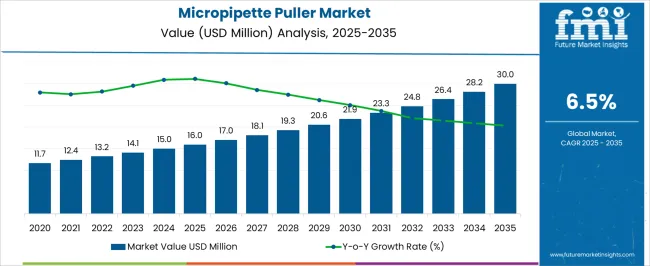
| Metric | Value |
|---|---|
| Micropipette Puller Market Estimated Value in (2025 E) | USD 16.0 million |
| Micropipette Puller Market Forecast Value in (2035 F) | USD 30.0 million |
| Forecast CAGR (2025 to 2035) | 6.5% |
The Micropipette Puller market is experiencing steady growth driven by increasing demand for precision instruments in life sciences, biomedical research, and cellular biology applications. The current market environment is characterized by the adoption of high-accuracy laboratory equipment that supports advanced experimental techniques and reproducible results. Growth has been influenced by increasing investments in research infrastructure, expansion of academic and research institutions, and the rising focus on molecular biology and electrophysiology studies.
Technological advancements in automated micropipette pullers and enhanced filament materials have improved performance consistency and reduced operational errors. The market is also benefiting from growing awareness of laboratory best practices and the need for standardized micropipette preparation methods.
Future growth opportunities are expected in the integration of smart controls, programmable pulling protocols, and compatibility with diverse glass capillary types As research activities expand globally, demand for reliable and customizable micropipette pullers is expected to rise, providing long-term opportunities across academic, industrial, and healthcare research environments.
The micropipette puller market is segmented by product type, filament type, end user, and geographic regions. By product type, micropipette puller market is divided into Vertical Micropipette Puller, Laser Micropipette Puller, and Programmable Micropipette Puller. In terms of filament type, micropipette puller market is classified into Loop Filament, Horizontal Band Filament, and Trough Filament. Based on end user, micropipette puller market is segmented into Academic and Research Institutes, Biotech Companies, Pharmaceutical Companies, and Contract Research Organization. Regionally, the micropipette puller industry is classified into North America, Latin America, Western Europe, Eastern Europe, Balkan & Baltic Countries, Russia & Belarus, Central Asia, East Asia, South Asia & Pacific, and the Middle East & Africa.
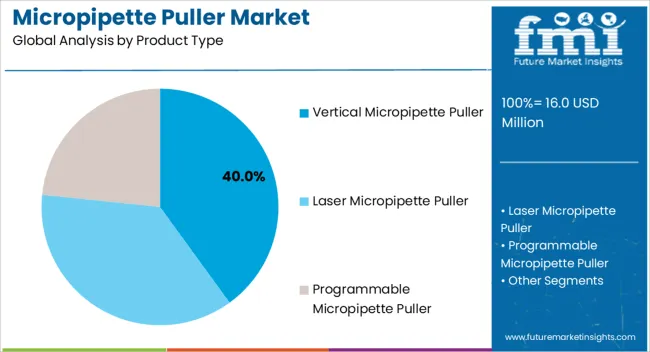
The Vertical Micropipette Puller segment is projected to hold 40.00% of the Micropipette Puller market revenue share in 2025, making it the leading product type. This prominence has been driven by the precision and reproducibility offered by vertical designs, which allow for highly controlled heating and pulling of glass capillaries. Vertical micropipette pullers are widely adopted in electrophysiology and single-cell studies, where consistent tip shape and size are critical for experimental accuracy.
The segment’s growth has been supported by the increasing emphasis on automated laboratory workflows and the need for instruments that minimize operator variability. The ability to program pull parameters and integrate temperature control has enhanced their utility in research applications.
Moreover, vertical micropipette pullers provide stable performance in high-throughput laboratories, making them attractive for academic and industrial research setups Continued advancements in heating elements, control software, and user interface designs are expected to sustain the segment’s leading position.
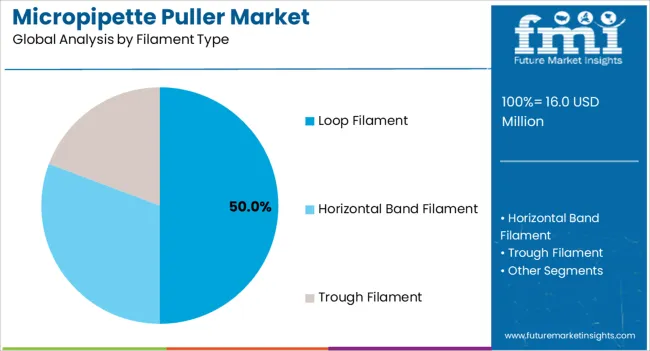
The Loop Filament type is anticipated to account for 50.00% of the Micropipette Puller market revenue in 2025, emerging as the most significant filament category. This leading share has been driven by the filament’s ability to provide uniform heating along the glass capillary, resulting in highly reproducible pipette tips.
Loop filaments are preferred for experiments requiring fine tip geometry and smooth surface finishes, which are critical in electrophysiology and microinjection applications. Adoption has been enhanced by compatibility with a wide range of micropipette pullers and ease of replacement, reducing operational downtime in research laboratories.
The segment’s growth has been further supported by the increasing number of high-precision laboratory studies and the expansion of academic and research institutions globally With ongoing innovation in filament materials and heating efficiency, loop filaments are expected to maintain their leading position as researchers continue to prioritize consistency, reliability, and reproducibility in micropipette preparation.
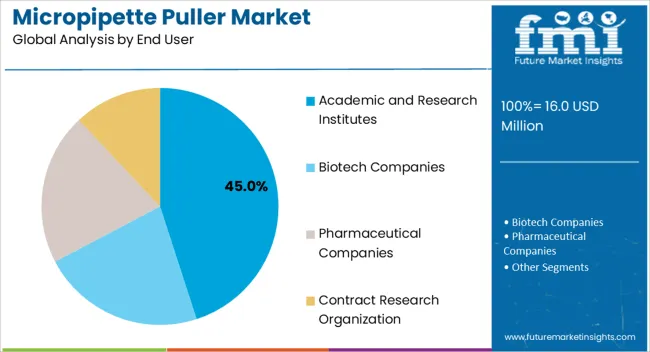
The Academic and Research Institutes end-use industry is expected to hold 45.00% of the Micropipette Puller market revenue share in 2025, making it the largest consumer segment. This leadership is being driven by the continuous expansion of universities, biomedical research centers, and laboratory facilities that require high-precision instruments for advanced research in molecular biology, neuroscience, and cellular physiology.
The adoption of micropipette pullers in academic settings is favored due to their ability to produce standardized pipette tips for reproducible experiments, which are essential for high-quality research outputs. Growth has also been supported by increasing research funding, collaborative international projects, and the emphasis on training students and researchers with sophisticated laboratory techniques.
Additionally, the need for automated and programmable equipment in educational laboratories to reduce manual variability has enhanced adoption As global research activity continues to rise, academic and research institutions are expected to remain the leading end-users, sustaining demand for reliable and advanced micropipette puller systems.
Micropipette are tools utilized in the laboratory to transfer small amounts of liquid. Micropipette are most used biology, pharmaceutical, chemistry, forensic and new drug discovery laboratory, among others. Various types of micropipette are used in everyday experiments and they need customization for performing different types of procedures.
Glass micropipettes are multipurpose probing tools that find applications in a variety of fields, including cell physiology, scanning probe microscopy, and micro-manipulation. Glass micropipettes can be fabricated either by chemical etching or by a physical technique called pipette pulling.
Micropipette puller is used in fabricating micropipettes, the micropipette puller enables attaining independent control of pipettes taper, bend-angle, tip diameter and also enables to maintain the theoretical derivation between the pipette shape and the pulling parameters. Micropipette puller consist of pipette heating system, the electronic controls of the micropipette puller and the mechanical motion stages.
The micropipette puller first heat the glass and softens it so as to pull it from both the end. The micropipette puller pulls the glass until it separates at the middle of the tube and created two tapered ends. By using the micropipette puller it gets easy to maintain the temperature and other parameters for maintaining the appropriate diameters of the taper and tip of the micropipette.
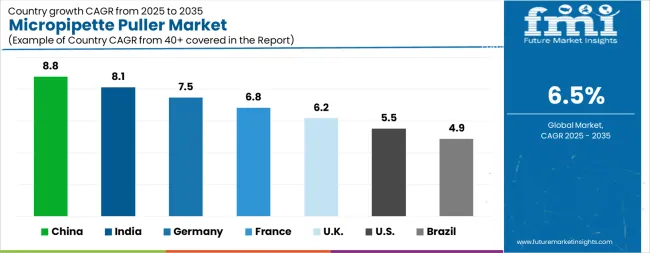
| Country | CAGR |
|---|---|
| China | 8.8% |
| India | 8.1% |
| Germany | 7.5% |
| France | 6.8% |
| UK | 6.2% |
| USA | 5.5% |
| Brazil | 4.9% |
The Micropipette Puller Market is expected to register a CAGR of 6.5% during the forecast period, exhibiting varied country level momentum. China leads with the highest CAGR of 8.8%, followed by India at 8.1%. Developed markets such as Germany, France, and the UK continue to expand steadily, while the USA is likely to grow at consistent rates. Brazil posts the lowest CAGR at 4.9%, yet still underscores a broadly positive trajectory for the global Micropipette Puller Market. In 2024, Germany held a dominant revenue in the Western Europe market and is expected to grow with a CAGR of 7.5%. The USA Micropipette Puller Market is estimated to be valued at USD 5.8 million in 2025 and is anticipated to reach a valuation of USD 10.0 million by 2035. Sales are projected to rise at a CAGR of 5.5% over the forecast period between 2025 and 2035. While Japan and South Korea markets are estimated to be valued at USD 787.7 thousand and USD 458.3 thousand respectively in 2025.
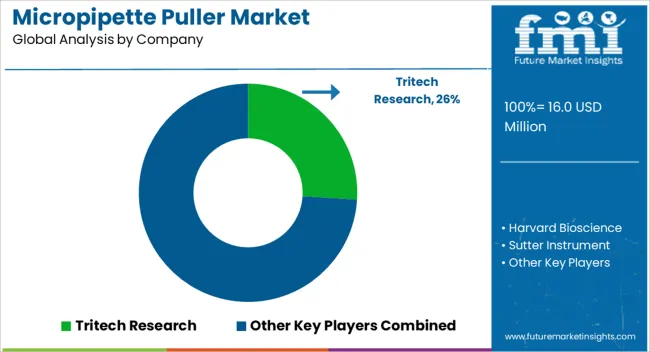
| Item | Value |
|---|---|
| Quantitative Units | USD 16.0 Million |
| Product Type | Vertical Micropipette Puller, Laser Micropipette Puller, and Programmable Micropipette Puller |
| Filament Type | Loop Filament, Horizontal Band Filament, and Trough Filament |
| End User | Academic and Research Institutes, Biotech Companies, Pharmaceutical Companies, and Contract Research Organization |
| Regions Covered | North America, Europe, Asia-Pacific, Latin America, Middle East & Africa |
| Country Covered | United States, Canada, Germany, France, United Kingdom, China, Japan, India, Brazil, South Africa |
| Key Companies Profiled | Tritech Research, Harvard Bioscience, Sutter Instrument, MicroData Instrument, Science Products, and Scitech Korea |
The global micropipette puller market is estimated to be valued at USD 16.0 million in 2025.
The market size for the micropipette puller market is projected to reach USD 30.0 million by 2035.
The micropipette puller market is expected to grow at a 6.5% CAGR between 2025 and 2035.
The key product types in micropipette puller market are vertical micropipette puller, laser micropipette puller and programmable micropipette puller.
In terms of filament type, loop filament segment to command 50.0% share in the micropipette puller market in 2025.






Full Research Suite comprises of:
Market outlook & trends analysis
Interviews & case studies
Strategic recommendations
Vendor profiles & capabilities analysis
5-year forecasts
8 regions and 60+ country-level data splits
Market segment data splits
12 months of continuous data updates
DELIVERED AS:
PDF EXCEL ONLINE

Thank you!
You will receive an email from our Business Development Manager. Please be sure to check your SPAM/JUNK folder too.
Chat With
MaRIA